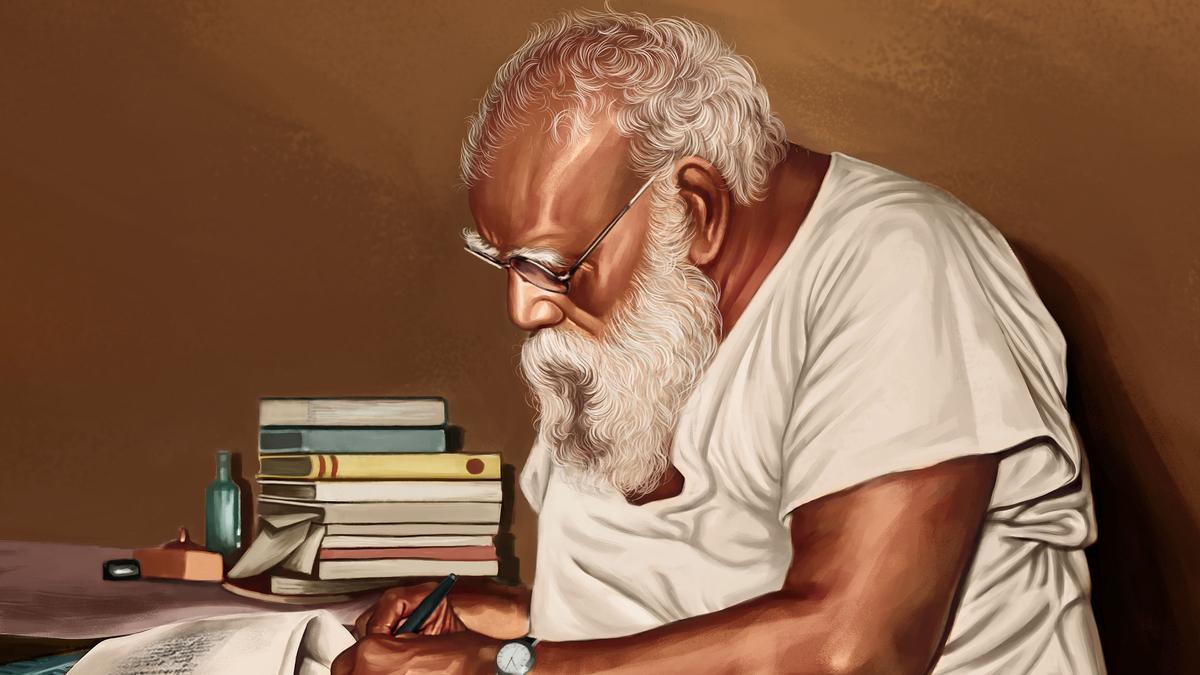Followers of Periyar insist that but for him and his reformist movement, Tamil Nadu would not have made strides in various fields.
| Photo Credit: The Hindu
Periyar E.V. Ramasamy, social reformer and founder of the Dravidar Kazhagam, remains the central point of political discourse in Tamil Nadu decades after his passing in 1973. It has become difficult to eliminate Periyar from the ideological spectrum — so much so that even one of Tamil cinema’s biggest stars, C. Joseph Vijay, declared him one of the guiding lights of his fledgling party, Tamilaga Vettri Kazhagam. The followers of Periyar insist that but for him and his reformist movement, Tamil Nadu would not have made strides in various fields.
However, in recent weeks, Seeman, the chief coordinator of Naam Tamilar Katchi, a Tamil nationalist party that polled over 8% of the votes in the 2024 Lok Sabha elections, has made Periyar the main target of his attack. Mr. Seeman has selectively resurrected Periyar’s long-forgotten comments against Tamil language, literature, and culture to portray him as “anti-Tamil”.
Tamil nationalists seeking to replace the Dravidian movement have begun to blame Periyar and his ideology as the root cause of what they call the “evils ravaging Tamil society.” They reject the term “Dravida” to collectively address the people of Tamil Nadu, Kerala, Andhra Pradesh, and Karnataka, and are highly critical of Periyar’s comments that “Tamil is a barbaric language.” They often say that Periyar’s so-called hatred for Tamil language and culture stems from his origin as a Kannada Naicker. They are in fact more vocal about their criticism of Periyar than Brahmins, who were consigned to the margins in the wake of the emergence of the Dravidian movement.
Periyar was never consistent with his views. He reconsidered them according to the changing circumstances, with good intention. “His five decades of public life have seen several political storms and shifting stands. But through all this he has remained unswerving in his fierce determination to ‘liberate’ Tamilians from the shackles of superstition, religion and God,” wrote the communist leader, Mythili Sivaraman, in her article, ‘The Relevance of Periyar: Caste or Class Struggle’, which is part of the book Haunted by Fire: Essays on Caste, Class, Exploitation, and Emancipation.
As an iconoclast, wedded to the idea of rationalism, Periyar rejected all ideas that were incompatible with science and denigrated human dignity. He launched scathing attacks against Tamil literary works, including the Kambaramayam, Silapathikaram, and even the Tirukkural, idolised by his disciples C.N. Annadurai, M. Karunanidhi, and others. He was furious when a Tamil scholar in Pachaiyappa’s College justified the decision of Kovalan, the hero of Silappathikaram, to leave his wife Kannagi “because she was not attractive”. Sivaraman wrote, “Periyar… championed the cause of widow marriage, marriage based on consent, women’s right to divorce to property, abortion and birth control. He… exposed the male superiority inherent in the concepts of chastity like karpu and pathivirathi that apply to women.”
Though Annadurai left Periyar to launch the Dravida Munnetra Kazhagam (DMK) as an antidote to the hardcore atheism preached by his mentor, Periyar’s principles remained a guiding force for Dravidian parties. Both Annadurai and Karunanidhi were at one point highly critical of Periyar and lampooned him through their writings and cartoons, but they could not fully eschew his ideology.
Periyar believed that Tamil society could not be liberated without breaking the backbone of Brahminsim, rooted in the concept of caste hierarchy by birth. The Bharatiya Janata Party could not make substantial progress in Tamil Nadu despite its campaign against Dravidian parties since humanism is the bedrock of Dravidianism. Mr. Seeman, who has an unmatched talent for stirring controversies, has targeted Periyar even though he was once his admirer. Tamil nationalists seem to think that they can weaken Dravidian parties only by undermining Periyar’s principles.
Tamils have protected their language and culture from the onslaught of Sanskrit and from centuries of conquests by non-Tamil rulers. Tamil Nadu has had non-Tamil Chief Ministers. Tamil nationalists argue that the Dravidian movement has failed to ensure a place for Tamils and has allowed non-Tamils to dominate the public and political sphere. Such arguments are bound to be put forth since identity politics has occupied central stage in Indian politics. It remains to be seen whether people will take the ‘Periyar versus Tamil nationalism’ bait.
Published – February 06, 2025 12:15 am IST
